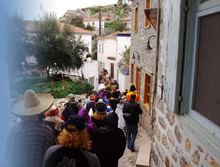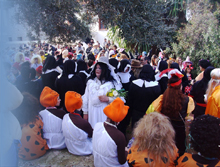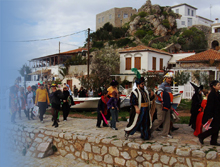As in whole Greece, hence
and in Hydra, the island's folkways are of great interest
to the tourists and the local people.
New Years Eve
At New Year's Eve the doors of the houses stay opened for the welcoming
of the visitors. The house owner hangs a ribbon to the
quest's neck and invites him for supper.
Epiphany in Hydra
Sanctification in Hydra island,
at the old days, took place on the eve of Epiphany, in order
to expel the goblins.
 All housewives of Hydra, at the eve of Epiphany,
went to the Church and after the
end of the Liturgy, with pitcher transported the holy water
on their homes, and then sanctified every corner of their
home, as the cisterns and their wells. The rest of the holy
water were stored in the icon for the rest of the year.
All housewives of Hydra, at the eve of Epiphany,
went to the Church and after the
end of the Liturgy, with pitcher transported the holy water
on their homes, and then sanctified every corner of their
home, as the cisterns and their wells. The rest of the holy
water were stored in the icon for the rest of the year.
Also on Epiphany Eve all the priests of the parishes of Hydra hallow
homes, shops and boats of parishioners.
The day
of the Epiphany, after the end of the sequence
of the Great Sanctification was formed great
procession with hymns and prayers, which was directed through
the old neighborhoods of Hydra - Kiafas-Gkourmadas - until
the Square Kalon Pigadionn, where the priests of the island
had the blessing of the two wells.
 Near
the noon, the procession reached the northern breakwater
of the harbor through the main street of Andrea Maiouli,
so the Cross tied with ribbon, fell to the sea from the
hands of the bishop, to sanctify the waters. Despot chanting "En
Jordan ..." and
threw the cross into the sea, freeing from his hands three
pigeons. With the plunge of the Cross at
Near
the noon, the procession reached the northern breakwater
of the harbor through the main street of Andrea Maiouli,
so the Cross tied with ribbon, fell to the sea from the
hands of the bishop, to sanctify the waters. Despot chanting "En
Jordan ..." and
threw the cross into the sea, freeing from his hands three
pigeons. With the plunge of the Cross at
Then they
all returned back at the Church to pray for a good year
and for their health. The children, who fell to the sea
to catch the Cross, they took it and went with it around the shops.
The consecration of the waters was also being done
by the parishioners of the Church of St. John the Baptist
in the harbor of Kamini Kamini since 1963.
The parade for the for the
consecration of Kala pigadia
The Epitaph in Kaminia and in Hydra in general
 One
of the most beautiful and most picturesque Hydra customs
is the immersion of the Epitaph in the sea, on Good Friday
evening, in Kamini beach
One
of the most beautiful and most picturesque Hydra customs
is the immersion of the Epitaph in the sea, on Good Friday
evening, in Kamini beach
On this particular day
the Epitaph, after its walking into the district, is being
immersed into the waters by people who support it for the
purpose of sunctifing the waters. With this custom they
believe the sailor will return fro their journey safe.
The custom was for the first time started in Kaminia
during the year 1923 and since then the custom is repeated every
year, according to tradition.
 The custom
started by sponge divers of Kaminia whose sponge boats
departed after the Sunday of the Holy Cross and returned
close to the day of the Exaltation of the Holy Cross.
The custom
started by sponge divers of Kaminia whose sponge boats
departed after the Sunday of the Holy Cross and returned
close to the day of the Exaltation of the Holy Cross.
The spectacle is magnificent, spectacular
and every Good Friday followed by faith and reverently by
all the parishioners and many foreigners come Kamini to
watch especially this custom.
The procession of the
Epitaph at Kaminia is being done earlier than what of the
rest of the Main place, to enable visitors to see all the
customs.
In the town of Hydra, after the pieta, the bells tolls.
First does the big bell of the convent bells, followed by
the remaining parishes of St. Barbara, the Visitation and
St. Demetrius. All Epitaphs gather at the north entrance
of the Holy Dormition Monastery, Square P. Kountouriotis
followed the procession of Epitaphs through the cobbled streets of the
town of Hydra.
The Resurrection and Easter in Hydra
The Resurrection is being
done in an atmosphere full of faith by the candlelights,
in all churches of the island, and ends
with the traditional roasting spit.
The burning of Judas in Hydra
 All
parishes of Hydra had the custom of burning
Judas,
from old times, at the eve of Easter
Sunday. The competition between parishes was great and
indeed, during thr Holy Week, churches gouged tray to
cover the expenses for the custom.
All
parishes of Hydra had the custom of burning
Judas,
from old times, at the eve of Easter
Sunday. The competition between parishes was great and
indeed, during thr Holy Week, churches gouged tray to
cover the expenses for the custom.
The preparation for the construction of Judah began long
before the start of the Holy Week. They made the large doll as a real man,
with the correct size and dress him up with
Jewish clothes. Inside the doll put straws.
The doll's left hand made straight
and into a fist, except from a finger from where they hung a purse with the
30 silver coins of the betrayal.
The traditional Hydraian wedding
Another custom is the traditional Wedding that
takes place in Hydra. It starts with the traditional making
of the bed, in
which friends and relatives of the married-to-be throw on
to the sheets money.
The eve before the wedding the future bride is being
shampooed and combed from other married women. Often the
bride does not wear a wedding dress, but the traditional clothing of
Hydra.
After the wedding was customary to be held a wedding
feast, with the accompany of music from traditional musical
organs,in honour of the married couple.
The Betrothal in the old Hydra
In the old times, people in Hydra were betrothed in a very young age,
from 14 for the girls and 18 the boys. If you were older
and not betrothed then the village used to taunt you.
Your father or
brothers if you had no father, had to pay for the wedding
and if a woman was an only child and fatherless, then her mother had
to take care of the wedding expenses.
A brother and especially
the oldest one, had to wait until his sister to get married,
and then get married himself. That thing has been honourable
and you gained a lot of respect from the other village
people.
Then there were the presents. From the father and brothers of the
soon to be bride to the family of the groom and of course
vise versa. Presents from rings and golds and golden coins.
After this exchancing of presents there was a dinner with all the
family members, of the grooms and the bride's, accompanied
with music and singing. The betrothal didn't last long because
the couple had to get married. There were a lot of visiting
from the bride to the groom's family, bringing presents and
vise versa, until the final day of the wedding. This was
being done in order for the couple to get to know the other's
family.
The Carnival
Very famous in Hydra is the annualCarnival where tourists
and local people can take part and enjoy. The festival
is going around all the paths of the main city of Hydra and it ends
at the port with fireworks, as entertainment continues all the night.
 The start of the Carnival in Hydra signaled
in past years, the day of commemoration of St. Anthony the
Great in the 17th of January.
The start of the Carnival in Hydra signaled
in past years, the day of commemoration of St. Anthony the
Great in the 17th of January.
On this day, in all the
neighborhoods of Hydra, the carnival people began to beat
drums and drums, announcing the joyful message of Halloween.
Today, the carnival are gathered in the square of Admiral
Votsi and then climb the stairs of the road Anthony Lygnou.
After the Mansion of Sahtouris, they turn right and arrive
at Hillary's pit, where they make their first stop. There,
they dance with island songs and with the accompaniment
of treats.
Then, via the route Anthony Kriezis leading Kamini and bypassing
the route at the height of the Church of the Virgin, directed
toward pit Tzathas or Bampori.
Moving to position Petalidiza, near the
Church of St. Barbara, turning west and heading for the
port of Kamini.
 Passing the river end of Kaminion, they
end at the Lakka of Kokoris, and make the second stop with treats and dances.
After the second stop, the carnival is directed towards the Church of the
Ascension and follow the road up the tower leading to Lakka Gavrili
for the third and final stop of the procession of the carnival.
Passing the river end of Kaminion, they
end at the Lakka of Kokoris, and make the second stop with treats and dances.
After the second stop, the carnival is directed towards the Church of the
Ascension and follow the road up the tower leading to Lakka Gavrili
for the third and final stop of the procession of the carnival.
Then the carnival from the pit
Gavrili descends to the street of Anthony Lignou to reach
again the square of Admiral Votsi and from there the carnival
parade, with drums and Drums, goes to beach of Hydra, where
the dance and songs are.
In the end, the carnival, after
the beach of Hydra, passes the route of George Sachtouri
and ends at the tavern "Xeri Elia" where it hangs. Followed
by dancing and feasting on traditional food and good wine.













